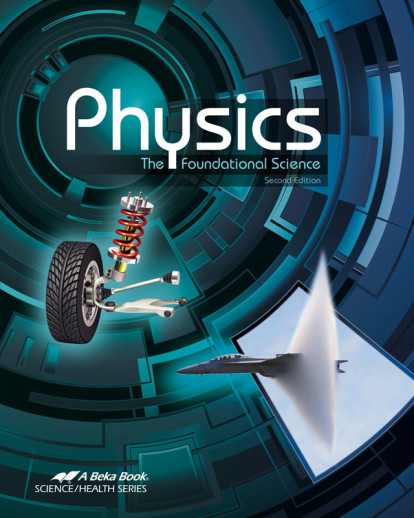We use cookies to make your experience better. To comply with the new e-Privacy directive, we need to ask for your consent to set the cookies. Learn more.
Physics: The Foundational Science Student Textbook
The student textbook provides textual readings, numerous articles that apply physics in everyday life, biographies of Christian physicists, key equations, chapter questions and numerous math problems to solve. Space to record answers is not included, so students will need a separate notebook. Abundant illustrations are included, along with key symbols, abbreviations, and equations.
Why didn't the golf ball fly straight after it was hit? Why are race tracks inclined? How is a boat made of metal able to float? Answer these questions and more with Physics: The Foundational Science. Present the theoretical and practical aspects of physics as your child studies friction, gravity, energy, momentum, thermodynamics, and more. With over 500 illustrations, example equations, section questions, application problems, your child can understand the laws of creation as God has set them into motion.
Beginning with an overview of God's revelation and man's dominion, students study the principles of classical and modern physics, matter, energy, and mechanics. The course also includes an overview of recent developments in physics from particle physics to electronics, lasers, and relativity. The focus is on the knowledge and application of physics. Mathematical equations are integral. According to the publisher, Algebra 1 is a prerequisite, although an understanding of Geometry and Trigonometry may also be beneficial.
The student textbook provides textual readings, numerous articles that apply physics in everyday life, biographies of Christian physicists, key equations, chapter questions and numerous math problems to solve. Space to record answers is not included, so students will need a separate notebook. Abundant illustrations are included, along with key symbols, abbreviations, and equations.
The teacher guide provides the full student text at the beginning and the teaching resources in the back section. Teacher resources include a scope and sequence with a suggested teaching schedule, daily lessons with chapter overview, bonus demonstrations, teacher preparation notes and the teaching procedures. Answers are not included. A separate solution key contains question answers and the math equations with solutions.
Additional resources include the Lab Manual, Quiz Book, and the Test Book. Answers are not included; each offers a separate teacher guide or answer key.
The lab manual provides 20 experiments to solidify the text readings. Similarly formatted, each experiment provides the purpose and introduction, equipment list, step-by-step procedures and a report sheet. You will need to provide numerous items including safety glasses, graduated cylinders, beakers, Celsius thermometer, triangular glass prism, etc. Please contact Rainbow Resource for a full list.
The Lab Manual Teacher Guide includes the complete student lab manual with answers, a suggested schedule, and general teaching suggestions and notes for each experiment. A comprehensive listing of necessary supplies/equipment is also included.
The test book provides a total of 12 exams: 8 tests (one every 3 weeks), 2 nine-week exams, a semester exam, and a final exam. It also includes a math pre-test to help parents and students identify any math concepts that may need to be reviewed. Questions vary from reading comprehension to higher level thinking and application questions. The quiz book contains 42 quizzes (about 2 per chapter) which may include multiple choice, true or false, matching and math equations. Answers for the test book and quiz book are found in the corresponding answer keys. Student and teacher resources are not reproducible.
Also available are the Physics Student and Parent Kits. The student kit includes the textbook, test book, quiz book, and lab manual. The parent kit includes the teacher edition, solution key, the test key, quiz key, and the Lab Manual Teacher Edition.

